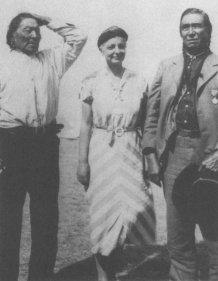When it comes to classic anthropology, Margaret Mead may garner the lionesses’ share of attention but Ruth Benedict remains the matriarch. Although Benedict today is dismissed by some as a quaint relic of the “culture and personality” school of anthropology, such demurrals underestimate the theoretical sophistication and continuing relevance of Benedict’s work.
Those who understand Patterns of Culture as a psychoanalytic riff on national character probably haven’t read it. Nietzsche’s analysis of ancient Greek culture as an Apollonian-Dionysian dialectic is a tour de force; Benedict’s similar treatment of the Zuni, Dobu, and Kwakiutl is on par. And despite all the fieldwork-obsessed criticism of The Chrysanthemum and the Sword: Patterns of Japanese Culture, it is still read by the Japanese and nearly everyone interested in Japan.
About once a year, I am reminded of Benedict’s enduring relevance. It usually happens when I come across something she has written but which was not published or is hidden away. Because Benedict was prolific and her interests so broad, this happens surprisingly often. This year I came across her 1938 “Religion” essay in General Anthropology (open access), a massive tome edited by Benedict’s teacher and mentor Franz Boas.
Although Benedict pays homage to her particularist training and the description is thick, her assay of religion betrays a deeper interest in underlying patterns and themes. The tension is palpable. Her desire to explain is repressed.
Something similar can be found in “The Vision in Plains Culture” (open access), Benedict’s vivid account of the Native American vision quest and its varying deployment among tribes from coast to coast. Published in 1922, it remains the standard reference for those who study the distinctive vision complex of the Great Plains culture area.

Ruth Benedict with Blackfeet Informants
Benedict organizes her data around three patterns that others have considered characteristic of the Plains area vision quest: (1) the infliction of self-torture, (2) the lack of a laity-shaman distinction in seeking visions, and (3) the attaining of a guardian spirit. In typical Boasian fashion, Benedict then shows that while there may be some truth to these patterns, there are many variations and the generalizations don’t always hold. She does, however, identify one that does: in the Plains area, vision seeking is an “affair of maturity and not of adolescence.” Just east or west of the Plains and toward either coast, vision seeking is usually associated with liminal rites that mark passage from adolescence to adulthood.
In closing, Benedict mimics her mentor Boas and reminds us that all this variation argues against generalization:
The very great diversity of the vision pattern even in one culture area such as the Plains is therefore evident. Not only are the general traits unevenly and even entirely lacking in certain tribes, but local developments of one kind and another have overlaid the common pattern till it is at times hardly recognizable. A blanket classification under some such heading as the “acquiring of guardian spirits” leads us nowhere.
[T]he utmost diversity which makes of Plains “religion” a heterogeneity. Animism, magic, mana-ism, mysticism — all the known classifications of religion — jostle with each other in this one area; and after all these headings were tabulated, the real diversities would still remain outside.
These points are well taken. But as is so often the case with Benedict’s work, her appended admonition does little to obscure the larger patterns and explanations lurking throughout the article. Diversity is a pattern that tells us something important about nomadic supernaturalism: across time and space, it is fluid.
As is often the case with incisive thinkers and good writers, Benedict’s mere “description” is organized and presented in a way which smacks of analysis. By showing, she tells.
Reference:
Benedict, R. (1922). The Vision in Plains Culture American Anthropologist, 24 (1), 1-23 DOI: 10.1525/aa.1922.24.1.02a00020



